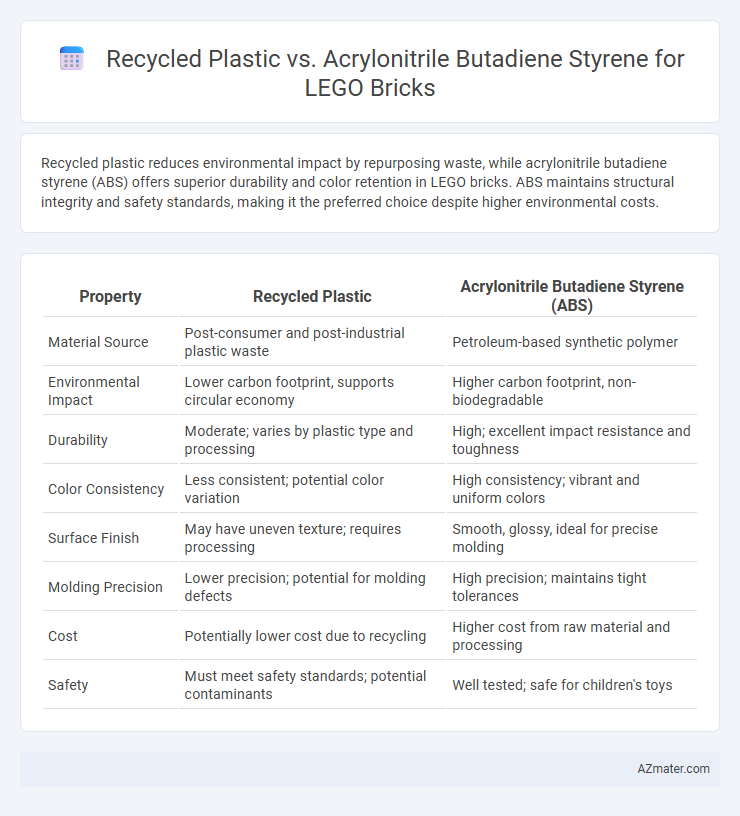Recycled plastic reduces environmental impact by repurposing waste, while acrylonitrile butadiene styrene (ABS) offers superior durability and color retention in LEGO bricks. ABS maintains structural integrity and safety standards, making it the preferred choice despite higher environmental costs.
Table of Comparison
| Property | Recycled Plastic | Acrylonitrile Butadiene Styrene (ABS) |
|---|---|---|
| Material Source | Post-consumer and post-industrial plastic waste | Petroleum-based synthetic polymer |
| Environmental Impact | Lower carbon footprint, supports circular economy | Higher carbon footprint, non-biodegradable |
| Durability | Moderate; varies by plastic type and processing | High; excellent impact resistance and toughness |
| Color Consistency | Less consistent; potential color variation | High consistency; vibrant and uniform colors |
| Surface Finish | May have uneven texture; requires processing | Smooth, glossy, ideal for precise molding |
| Molding Precision | Lower precision; potential for molding defects | High precision; maintains tight tolerances |
| Cost | Potentially lower cost due to recycling | Higher cost from raw material and processing |
| Safety | Must meet safety standards; potential contaminants | Well tested; safe for children's toys |
Introduction: The Evolution of LEGO Brick Materials
LEGO bricks have evolved from traditional acrylonitrile butadiene styrene (ABS) to incorporating recycled plastics to enhance sustainability and environmental impact. ABS remains the preferred material due to its strength, durability, and vibrant color retention, essential for LEGO's precise interlocking system. Recent advancements in recycling technologies enable LEGO to produce bricks from high-quality recycled plastics without compromising the structural integrity and safety standards of their iconic products.
Understanding Recycled Plastic in Modern Manufacturing
Recycled plastic in modern manufacturing offers significant environmental benefits by reducing waste and conserving resources, making it an attractive alternative to traditional materials like Acrylonitrile Butadiene Styrene (ABS), which is commonly used for LEGO bricks due to its strength and durability. Advances in recycling technology enable the production of high-quality recycled plastic that meets stringent safety and performance standards required for toy manufacturing. This shift supports sustainability goals while maintaining the structural integrity and vibrant colors essential for LEGO bricks.
Acrylonitrile Butadiene Styrene (ABS): Traditional LEGO Material
Acrylonitrile Butadiene Styrene (ABS) is the traditional material used in LEGO bricks due to its exceptional strength, durability, and color retention, ensuring long-lasting, high-quality products. ABS's impact resistance and precise molding capabilities maintain the iconic LEGO brick's clutch power and consistent fit, essential for complex builds. While recycled plastic options are being explored, ABS remains the gold standard for performance and safety in LEGO manufacturing.
Environmental Impact: Recycled Plastic vs ABS
Recycled plastic LEGO bricks significantly reduce greenhouse gas emissions and energy consumption compared to traditional Acrylonitrile Butadiene Styrene (ABS), as recycled materials divert waste from landfills and lower reliance on fossil fuels. ABS production generates substantial carbon emissions and non-biodegradable waste, contributing to environmental pollution and resource depletion. Transitioning to recycled plastics supports circular economy principles by minimizing plastic waste and promoting sustainable manufacturing practices in the toy industry.
Material Properties: Durability and Safety Comparison
Recycled plastic and Acrylonitrile Butadiene Styrene (ABS) both offer robust durability, but ABS is preferred for LEGO bricks due to its superior impact resistance and dimensional stability, ensuring long-lasting performance under repeated stress. Safety-wise, ABS is non-toxic and has consistent quality control, minimizing the risk of harmful chemical leaching compared to recycled plastics that may contain impurities affecting safety standards. The precise mechanical properties of ABS, such as high tensile strength and resistance to heat, make it a safer and more reliable material choice for children's toys like LEGO bricks.
Production Cost Analysis: Recycled Plastic vs ABS
Recycled plastic offers a lower production cost for LEGO bricks compared to Acrylonitrile Butadiene Styrene (ABS), primarily due to reduced raw material expenses and energy consumption during manufacturing. ABS, while providing superior strength and color consistency, involves higher costs linked to petrochemical extraction and refining. Balancing cost efficiency with quality requirements remains critical in the choice between recycled plastic and ABS for LEGO brick production.
Color Vibrancy and Texture Differences
Recycled plastic LEGO bricks often exhibit slight color variations and reduced vibrancy compared to the consistent, bright hues of Acrylonitrile Butadiene Styrene (ABS) bricks, due to impurities in recycled materials. ABS provides a smooth, glossy texture that enhances the tactile experience and color saturation, while recycled plastic bricks may feel rougher and less uniform in finish. These differences impact the overall aesthetic appeal and surface smoothness, influencing user perception of quality and visual consistency in LEGO sets.
Consumer Perception and Market Acceptance
Consumer perception of recycled plastic LEGO bricks often centers on environmental benefits, appealing to eco-conscious buyers seeking sustainable products. Acrylonitrile butadiene styrene (ABS) is traditionally favored for its durability, color vibrancy, and consistent quality, contributing to strong market acceptance and brand loyalty. Market adoption of recycled plastic LEGO is growing, but challenges remain in matching the tactile and aesthetic properties of ABS, influencing consumer confidence and long-term acceptance.
Future Trends: LEGO’s Sustainability Initiatives
LEGO is advancing its sustainability initiatives by increasingly incorporating recycled plastic into their brick manufacturing, aiming to reduce dependence on acrylonitrile butadiene styrene (ABS), the traditional material known for durability and color retention. Future trends indicate a shift towards bio-based and recycled polymers that maintain the mechanical properties required for LEGO bricks while significantly lowering environmental impact. Research investments and pilot programs focus on balancing material performance with circular economy principles to achieve carbon neutrality by 2030.
Conclusion: Choosing the Right Material for LEGO Bricks
Recycled plastic offers an eco-friendly alternative for LEGO bricks, reducing environmental impact while maintaining adequate durability and safety standards. Acrylonitrile butadiene styrene (ABS) remains the industry benchmark due to its superior strength, color retention, and precision molding. Selecting between recycled plastic and ABS depends on balancing sustainability goals with the performance and quality expectations essential for LEGO's brand reputation.

Infographic: Recycled plastic vs Acrylonitrile butadiene styrene for LEGO brick
 azmater.com
azmater.com